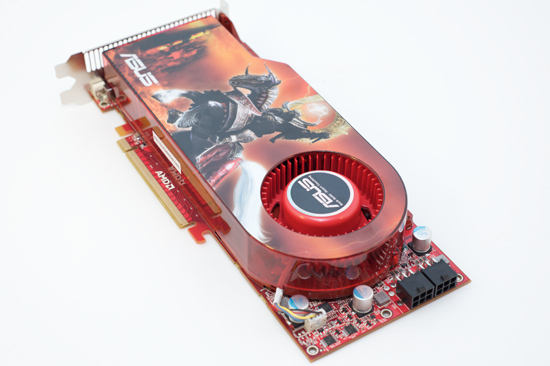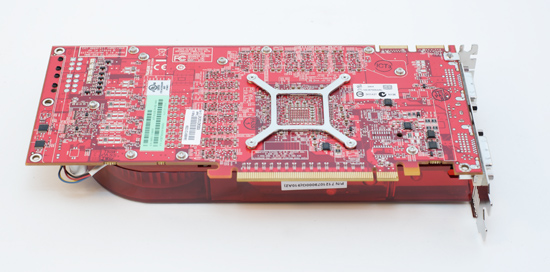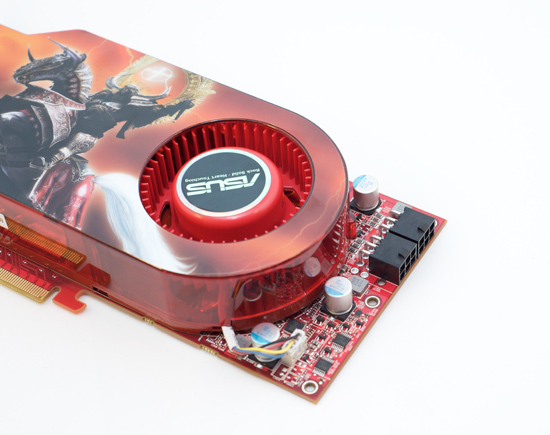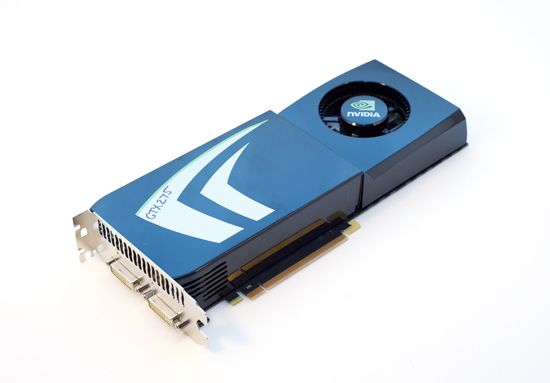ATI Radeon HD 4890 vs. NVIDIA GeForce GTX 275
by Anand Lal Shimpi & Derek Wilson on April 2, 2009 12:00 AM EST- Posted in
- GPUs
The Cards and The Test
In the AMD department, we received two cards. One was an overclocked part from HIS and the other was a stock clocked part from ASUS. Guess which one AMD sent us for the review. No, it's no problem, we're used to it. This is what happens when we get cards from NVIDIA all the time. They argue and argue for the inclusion of overclocked numbers in GPU reviews when it's their GPU we're looking at. Of course when the tables are turned so are the opinions. We sincerely appreciate ASUS sending us this card and we used it for our tests in this article. The original intent of trying to get a hold of two cards was to run CrossFire numbers, but we only have one GTX 275 and we would prefer to wait until we can compare the two to get into that angle.



The ASUS card also includes a utility called Voltage Tweaker that allows gamers to increase some voltages on their hardware to help improve overclocking. We didn't have the chance to play with the feature ourselves, but more control is always a nice feature to have.

For the Radeon HD 4890 our hardware specs are pretty simple. Take a 4870 1GB and overclock it. Crank the core up 100 MHz to 850 MHz and the memory clock up 75 MHz to 975 MHz. That's the Radeon HD 4890 in a nutshell. However, to reach these clock levels, AMD revised the core by adding decoupling capacitors, new timing algorithms, and altered the ASIC power distribution for enhanced operation. These slight changes increased the transistor count from 956M to 959M. Otherwise, the core features/specifications (texture units, ROPs, z/stencil) remain the same as the HD4850/HD4870 series.
Most vendors will also be selling overclocked variants that run the core at 900 MHz. AMD would like to treat these overclocked parts like they are a separate entity altogether. But we will continue to treat these parts as enhancements of the stock version whether they come from NVIDIA or AMD. In our eyes, the difference between, say, an XFX GTX 275 and an XFX GTX 275 XXX is XFX's call; the latter is their part enhancing the stock version. We aren't going to look at the XFX 4890 and the XFX 4890 XXX any differently. In doing reviews of vendor's cards, we'll consider overclocked performance closely, but for a GPU launch, we will be focusing on the baseline version of the card.
On the NVIDIA side, we received a reference version of the GTX 275. It looks similar to the design of the other GT200 based hardware.

Under the hood here is the same setup as half of a GTX 295 but with higher clock speeds. That means that the GTX 275 has the memory amount and bandwidth of the GTX 260 (448-bit wide bus), but the shader count of the GTX 280 (240 SPs). On top of that, the GTX 275 posts clock speeds closer to the GTX 285 than the GTX 280. Core clock is up 31 MHz from a GTX 280 to 633 MHz, shader clock is up 108 MHz to 1404 MHz, and memory clock is also up 108 MHz to 2322. Which means that in shader limited cases we should see performance closer to the GTX 285 and in bandwicth limited cases we'll still be faster than the GTX 216 because of the clock speed boost across the board.
Rather than just an overclock of a pre-existing card, this is a blending of two configurations combined with an overclock from the two configurations from which it was born. And sure, it's also half a GTX 295, and that is convenient for NVIDIA. It's not just that it's different, it's that this setup should have a lot to offer especially in games that aren't bandwidth limited.
That wraps it up for the cards we're focusing on today. Here's our test system, which is the same as for our GTS 250 article except for the addition of a couple drivers.
The Test
| Test Setup | |
| CPU | Intel Core i7-965 3.2GHz |
| Motherboard | ASUS Rampage II Extreme X58 |
| Video Cards | ATI Radeon HD 4890 ATI Radeon HD 4870 1GB ATI Radeon HD 4870 512MB ATI Radeon HD 4850 NVIDIA GeForce GTX 285 NVIDIA GeForce GTX 280 NVIDIA GeForce GTX 275 NVIDIA GeForce GTX 260 core 216 |
| Video Drivers | Catalyst 8.12 hotfix, 9.4 Beta for HD 4890 ForceWare 185.65 |
| Hard Drive | Intel X25-M 80GB SSD |
| RAM | 6 x 1GB DDR3-1066 7-7-7-20 |
| Operating System | Windows Vista Ultimate 64-bit SP1 |
| PSU | PC Power & Cooling Turbo Cool 1200W |










294 Comments
View All Comments
johnjames - Monday, May 18, 2009 - link
I don't get it, I started reading this review and decided to get a 4890, then I read the following reviews:[url]http://www.driverheaven.net/reviews.php?reviewid=7...[/url]
[url]http://www.bit-tech.net/hardware/graphics/2009/04/...[/url]
[url]http://www.bjorn3d.com/read.php?cID=1539&pageI...[/url]
[url]http://www.dailytech.com/422009+Daily+Hardware+Rev...[/url]
[url]http://www.guru3d.com/article/geforce-gtx-275-revi...[/url]
[url]http://www.legitreviews.com/article/944/15/[/url]
[url]http://www.overclockersclub.com/reviews/nvidia_3d_...[/url]
[url]http://www.hardwarecanucks.com/forum/hardware-canu...[/url]
[url]http://hothardware.com/Articles/NVIDIA-GeForce-GTX...[/url]
[url]http://www.engadget.com/2009/04/02/nvidia-gtx-275-...[/url]
[url]http://www.overclockersclub.com/reviews/nvidia_gtx...[/url]
[url]http://www.pcper.com/article.php?aid=684&type=...[/url]
And they all state the GTX 275 gives a lot more fps in all games bar Grid.
genetix - Wednesday, September 23, 2009 - link
This is actually really funny you mention multiple sites. Since it's pretty hard to find an site these days which actually doesn't review/preview without sponsors. Meaning lean to one side to other is pretty simplistic just need to review right games and voila either can win. Lol, looking ATI videos damn those are so well selected that damn.We are definedly getting back to 80s where games where made to GPU. Not to all. The funny thing is even our so trusted Benchmarks like any Futuremark production fakes the results of GPUs. Their so called ORB is pretty far from reality what the hardware is really capable.
Asianman - Tuesday, June 16, 2009 - link
most of those use either NV biased games or most likely didn't upgrade the 4890's drivers. All reviews show that 4890 loses its initial advantage at higher resolutions, and the fact that it is now much cheaper. Take your pick, you'd get good value either way.Patrick Wolf - Sunday, August 2, 2009 - link
Well the 4890 isn't exactly kicking the 275's butt here.Let me break it down:
Age of Conan: 0-3 fps difference. It's a wash
CoD: WaW: 275 is at or above 60 fps on all resolutions, beats 4890 at 2560. 275 wins.
Crysis Warhead: 0-2 fps difference. It's a wash.
Fallout 3: 4890 wins.
Far Cry 2: 0-2 fps difference. It's a wash.
Left 4 Dead: Again, 275 is at or above 60 fps on all resolutions, beats 4890 at 2560. 275 wins.
Grid: 4890 wins.
That's 2 for nvidia, 2 for ATI. And on COD, Crysis, Far Cry, and L4D the 4890 wins at 1680 and 1920, then at 2560 the 275 suddenly pulls ahead? That's supposed to make sense? Not to mention both drivers used were beta. And the 185.65 drivers have been pulled from nvidia's archives.
pinguw - Friday, April 17, 2009 - link
yes, you said the one that is getting the benefit are the end user, but I think you have a short vision, because when things getting cheapper means we have more chance to get lower quality product. for example, the GTX260 that I bought several month a go, I can see that the image was worse than the 8800GTS that I had 2 years. At beggining I thought it was a defect so I changed other one and other brand and had the same result. so I say, instead of fighting for price, why dont they just make a better product?? lowering the price would just get our product worse and worse, like most of the product sold in US are now made in China... and then everybody are complaining about the product is bad... that is poisoned etc, what a joke what do you expect when the price go down? the answer is easy to get right? So I would suggest you stopping saing the one is getting the benefit are the users, what a brainless commentjoeysfb - Tuesday, April 28, 2009 - link
Something is not right here, are you linking the lowering of product quality to ficere competition???That's why people read reviews, comments from Neweggs, Amazons... to find out the user experience before buying a desired product...
Almost everythings is made in china now...like it or not.
8KCABrett - Thursday, April 16, 2009 - link
Those of us that buy the latest hardware to fly our flight sims have been pretty much left to using the outdated Tom's Hardware charts (which still show the 8800GTS being the fastest card around). I would love to know how the Q9650s and i7s are doing in FSX since the service packs, and it would be great to learn if the GTX 260/280s and now the refreshes are still slower than an 8800GTS in those sims. . .not to mention the abysmal performance of ATI cards! Has anyone found such a review anywhere?joeysfb - Friday, April 17, 2009 - link
just stick to 8800GTS then (money saved)... besides there not many sim titles these days.BikeDude - Friday, April 17, 2009 - link
Stick with the 8800GTS?I do not think you realize the problem. A year ago, FSX ate all the hardware you could throw at it.
FSX is a very difficult animal to feed.
It loves fast CPUs, but it also needs a fast GPU. Unfortunately, as was pointed out, there exists few recent comparisons. It is not easy figuring out the correct hw balance for FSX, since few includes it in a review.
Comparing dozens of FPS games is pointless. They perform similar. There are some small differences, but to evaluate a given card, you don't have to review that many games. FSX however poses some unique challenges, and deserves some attention.
Oh... I'd also like to know which of these cards will play nicely with HD video.
8KCABrett - Tuesday, April 21, 2009 - link
Well, every now and then I like to have a little shooter fun, and the GTS is certainly lagging behind in the new titles.I'm currently beta testing a new sim and it really utilizes the GPU which is nice to see, but my 8800GTS limits me quite a lot, and it's also nicely multi-threaded. I decided it's time to update my system, and really have nothing to guide me. Is ATI still really weak in sims? Have the GTX 280s gotten any better with the recent drivers? What about SP2 in FSX? I just don't have any source of this info, and I've looked everywhere for a legit source.
I've got a GTX 285 on the way and will just end up doing my own testing since that's apparently the only way to get the info.
There are hundreds of review sites out there posting these same four or five titles in their benchmarks and not a single one that includes any of the flight sims, even the new releases. I know sims are a niche market, but flight simmers are left to test for themselves, and they use what is perhaps one of the more demanding titles out there! My complaint isn't directed at Anandtech per se, I favor this site and have seen and appreciated the helpfulness of Gary Key time and again, especially over at the Abit forums, I just wish that Anandtech could employ their testing discipline in titles that really do need a legit place to evaluate them. It could really be a benefit to many people that really aren't catered to at all currently.
OK. . .back to lurking.